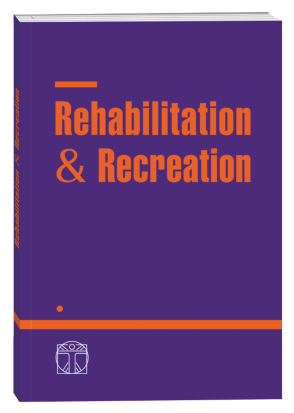PHYSICAL THERAPY FOR CHILDREN AGED 10–12 YEARS WITH II DEGREE OF SCOLIOSIS
DOI:
https://doi.org/10.32782/2522-1795.2022.11.1Keywords:
physical therapy, children aged 10–12 years, programAbstract
The article is devoted to a topical issue – the development of scoliosis in children aged 10–12 years. It is important that with each passing year there is a tendency to a steady increase in the number of children with this pathology. The purpose of this work was to analyze the data of scientific and methodological literature on the development, treatment and physical therapy of scoliosis in adolescents, and to develop a program of physical therapy for children with scoliosis II degree. The main causes of musculoskeletal disorders are considered. The analysis of literature sources on the etiology, pathogenesis, basic methods of treatment and physical therapy of children with scoliosis of II degree. It has been shown that the main objectives of physical therapy for scoliosis are to prevent further progression of the deformity, strengthen the muscular corset, prevent or treat spinal pain, improve aesthetics by correcting posture, improve respiratory function and cardiovascular health. The program of physical therapy of teenage children with scoliosis of the II degree which contains four consecutive stages is offered: adaptive, the first and second training and advanced. It should be noted that the design of the program should take into account the general factors that will inevitably lead to the success of treatment. To achieve the most effective treatment outcome, it is also important to keep in mind that the program must be individual for each child and comprehensive. It is also necessary to use the IFF-DP, which allows you to consider not only the diseases and problems of the child, but also a person who has their own needs and opportunities to realize their potential in everyday life. Systematic evaluation of treatment effectiveness, testing and modification of methods in the course of therapy is also very important for the success of treatment.
References
Аршин В. В., Чебыкин А. В. Сколиоз, причины и механизм развития, новый метод коррекци. Вестник медицинского института. РЕАВИЗ. 2015, 1. С. 55–57.
Аплевич В. М. Ефективність застосування кінезіотейпування у програмі відновлювального лікування ідіопатичного сколіозу ранніх ступенів у дітей старшого шкільного віку : дис. ... канд. мед. наук: Одеса, 2017. 181 с.
Бакалюк Т. Г., Чурпій І. К., Янів О. В., Стельмах Г. О., Телиця Є. Ю. Сучасні аспекти реабілітаційного обстеження при порушенні постави у людей молодого віку. Art of Medicine, 2020. 1 (13). С. 175–179.
Григус І. М., Нагорна О. Б., Горчак В. В. Реабілітаційне обстеження в практиці фізичного терапевта : навчальний посібник. Рівне, 2017. 130 с.
Давибіда Н. О., Попович Д. В., Безпалова Н. М., Довгань О. М., Коваль В. Б., Вайда О. В., Черній Ю. М. Масаж та лікувальна фізична культура як засоби фізичної реабілітації при різновидах сколіозу в дорослих та дітей з порушеннями опорно-рухового апарату. Здобутки клінічної і експериментальної медицини. 2019. № 2. C. 119–124.
Лукаш А. 500 упражнений для позвоночника. Корригирующая гимнастика для исправления осанки, укрепления опорно-двигательного аппарата и улучшения здоровья. Спб. : Наука и техника, 2008. 194 с.
Нагорна О. Б., Горчак В. В. Основи фізичної реабілітації: навчальний посібник. Рівне, 2017. 127 с.
Франк С., Франк М., Франк Г. Відновлювальне лікування ідіопатичного сколіозу методом мануальної терапії. World science, 2020. Vol. 1. 1 (53). С. 51–57.
International classification of functioning, disability and health: children & youth version: ICF-CY. World Health Organization. 2007. 301 p.
Kashuba V., Savliuk S., Chalii L., Zakharina I., Yavorsyy A., Panchuk A., Grygus I., Ostrowska M. Technology for correcting postural disorders in primary school-age children with hearing impairment during physical education. Journal of Physical Education and Sport. 2020. № 20 (Supplement issue 2), pp. 939–945.
Mechanism of right thoracic adolescent idiopathic scoliosis at risk for progression; a unifying pathway of development by normal growth and imbalance Wong CScoliosis 2015, 10: 2 (27 January 2015).
Negrini S., Donzelli S., Aulisa A. G. et al. (2018). 2016 SOSORT guidelines: orthopaedic and rehabilitation treatment of idiopathic scoliosis during growth. Scoliosis 13, 3. doi: 10.1186/s13013-017-0145-8
Nesterchuk N., Macyshyna K., Grygus I., Skalski D. (2018). Basic aspects of physical rehabilitation of children with scoliosis. Medycyna i zdrowie. Wybrane aspekty ratownictwa. Redakcja naukowa. Tom 3. Gdynia-Gdańsk-Starogard Gdański. 65–74. ISBN: 978-83-89481-26-9.
Protocol for diagnosis and treatment of patients with scoliosis. Order of the Ministry of Health of Ukraine dated July 26, 2006 No. 521 on the approval of Protocols for diagnosis and treatment of diseases and injuries of musculoskeletal system in children. 1.6. h t t p s : / / i p s . l i g a z a k o n . n e t / d o c u m e n t / MOZ6004?an=266
Downloads
Published
How to Cite
Issue
Section
License

This work is licensed under a Creative Commons Attribution-NonCommercial-NoDerivatives 4.0 International License.











